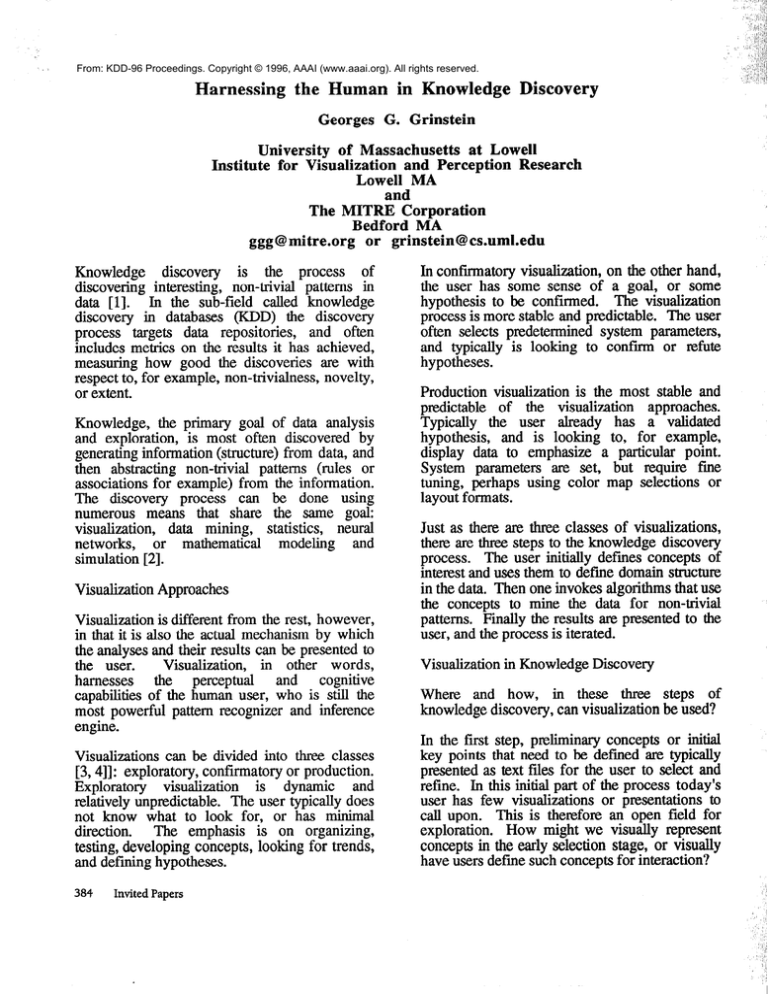
From: KDD-96 Proceedings. Copyright © 1996, AAAI (www.aaai.org). All rights reserved.
Harnessing the Human in Knowledge Discovery
Georges
G. Grinstein
University
of Massachusetts at Lowell
for Visualization
and Perception Research
Lowell MA
and
The MITRE Corporation
Bedford MA
ggg@ mitre.org
or grinstein@cs.uml.edu
Institute
Knowledge discovery is the process of
discovering interesting, non-trivial patterns in
In the sub-field called knowledge
data [l].
discovery in databases (KDD) the discovery
process targets data repositories, and often
includes metrics on the results it has achieved,
measuring how good the discoveries are with
respectto, for example, non-trivialness, novelty,
or extent.
Knowledge, the primary goal of data analysis
and exploration, is most often discovered by
generatinginformation (structure) from data, and
then abstracting non-trivial patterns (rules or
associationsfor example) from the information.
The discovery process can be done using
numerous means that share the same goal:
visualization, data mining, statistics, neural
networks, or mathematical modeling and
simulation [2].
Visualization Approaches
Visualization is different from the rest, however,
in that it is also the actual mechanismby which
the analysesand their results can be presentedto
Visualization, in other words,
the user.
harnesses the perceptual and cognitive
capabilities of the human user, who is still the
most powerful pattern recognizer and inference
engine.
Visualizations can be divided into three classes
[3,4]]: exploratory, confirmatory or production.
Exploratory visualization is dynamic and
relatively unpredictable. The user typically does
not know what to look for, or has minimal
direction. The emphasis is on organizing,
testing, developing concepts, looking for trends,
and defining hypotheses.
384
Invited Papers
In confirmatory visualization, on the other hand,
the user has some sense of a goal, or some
hypothesis to be confirmed. The visualization
processis more stable and predictable. The user
often selects predetermined system parameters,
and typically is looking to confirm or refute
hypotheses.
Production visualization is the most stable and
predictable of the visualization approaches.
Typically the user already has a validated
hypothesis, and is looking to, for example,
display data to emphasize a particular point.
System parameters are set, but require fine
tuning, perhaps using color map selections or
layout formats.
Just as there are three classes of visualizations,
there are three steps to the knowledge discovery
process. The user initially defines concepts of
interest and usesthem to define domain structure
in the data. Then one invokes algorithms that use
the concepts to mine the data for non-trivial
patterns. Finally the results am presentedto the
user, and the processis iterated.
Visualization in Knowledge Discovery
Where and how, in these three steps of
knowledge discovery, can visualization be used?
In the first step, preliminary concepts or initial
key points that need to be defined are typically
presentedas text files for the user to select and
refine. In this initial part of the process today’s
user has few visualizations or presentations to
call upon. This is therefore an open field for
exploration. How might we visually represent
concepts in the early selection stage, or visually
have usersdefme such conceptsfor interaction?
Successful presentationsat this stage will help
the user formalize concepts, and will make it
easierto focus the analytic tools.
In the second and third steps of knowledge
discovery, the user ideally interacts continually
with the selectedinformation-setting parameters,
fine-tuning, sub-selecting, and so on-based on
examination of the preliminary information
presented or visualized by the analytic tools.
This iterative activity is fundamental to the
discovery process,whether in KDD, or statistics,
or modeling and simulation. And it offers further
opportunities for innovative visualization
technique. While many tools today summarize
information visually, few offer the kind of
intermediary visualizations that could reduce the
number of iterations necessaryto reach a result.
We have to ask ourselves, then, how one can
visually present the resulting datasets and
summaries.
Visualization of databases, and more generally
datasets, is in its infancy. Best known ate
statistical representations of data, such as
statistical computations plotted in a variety of
ways: histograms, time series, scatterplots.
Modem approacheshave extended the scatterplot
concept. Whereas the pixel is a visual object
whose representationon the screen is driven by
three values (RGB or HLS, for example), an
icon may be driven by an arbitrary number of
values, permitting presentationof icons en masse
on the screen [5]. Such generalizationsenable us
to display larger, higher-dimensional datasets.
It is interactive displays of this kind that will
provide the mechanism, in effect the
breakthrough necessary, to harness our human
perceptual and cognitive capabilities. The user
will then fmally be able to interact visually with
the information, and thus more fully participate
with all the numerous components and steps of
the knowledge discovery process.
Presentation
We will present a brief history of alternative
visualizations and how they have been applied to
various data visualization problems.
The
emphasis will be on how visualization, in
particular exploratory visualization, can support
the knowledge discovery process, including
concept development for databasemanagement,
databasevisualizations, and minimally structured
datasetvisualizations.
References
[l] Frawley, W.J., Piatetsky-Shapiro, G. and
Matheus, C.J., 1991, Knowledge Discovery in
Databases: An Overview. In Knowledge
Discovery in Databases, Piatetsky-Shapiro and
Frawley, W. J., Editors, ALLWMIT Press, Vol
19, pp l-27.
[2] Fayyad, U.M., Piatetsky-Shapiro, G.,
Smyth, P., and Uthurusamy, R., 1996, Editors,
Advances in Knowledge Discovery and Data
Mining, AAAI Press.
[3] Grinstein, G., and John P. Lee, 1996,
Describing Visual Interactions to the Database:
Closing the Loop Between Users and Data,
Proceedingsof the Second SPIE’96 Visual Data
Exploration and Analysis Conference, San Jose,
pp 93-103.
[4] Lee, J.P. and Grinstein, G., 1995, An
Architechm for Retaining and Analyzing Visual
Explorations of Databases, 1995 IEEE
Visualization Conference Proceedings, Nielson
and Silver (Editors), pp 101-108.
[5] Erbacher, R., Grinstein, G., Levkowitz, H.,
Masterman, L., Pickett, R. , Smith, S., 1995,
Exploratory Visualization Research at the
University of Massachusetts at Lowell,
Computers and Graphics Journal, Special Issue
on Visual Computing, Vol 19, No 1, pp 131139.
Invited Papers
385
‘,’




